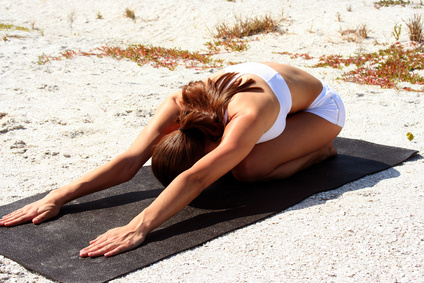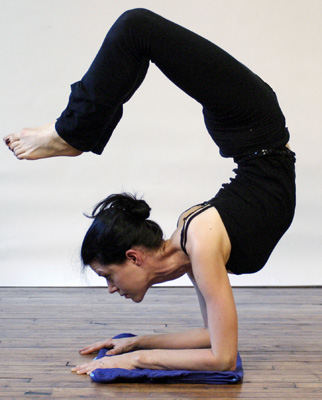At the core of your body, tied into each movement made by your arms, legs and neck, your back plays a crucial role in mobility. Tweak a muscle, bruise a rib or pinch a nerve trying out some crazy sex position you know is going to hurt long after the pleasure’s gone, and little things like sneezing will leave you doubled over. One month ago I did something to my back that sent screaming shocks of pain up my spine to the point where only lying in the fetal position eased discomfort. Running, spinning or any other form of exercising was launched out the window by a massive sling shot. Even standing for more than a few minutes at a time induced facial expressions synonymous with smelling dog crap or realizing The New Girl got renewed for another season.
Over the last several years I’ve relied on yoga as a form of exercise, inducer of mental calmness and as a reminder of how to breathe properly. In the past when it came to injuries, I’d refer to tried and true methods of icing, heating and resting until my body felt renewed enough to cut a rug once again. But this time around, after weeks of resting and only a slight improvement in pain, paired with my anxiety from not working out for so long, I decided grab the yoga mat and test out a stretching-through-injury theory. I couldn’t stand not exercising for so long, and I couldn’t stand being in pain anymore. I’ve always known yoga to work wonders on strengthening and lengthening the body, so it would (hopefully) make sense that my back would respond well to some heat, stretching and balancing exercises.
With the room’s temperature slowly scorching its way up to hover around 100 degrees, the studio I used to visit on a weekly basis felt like home again. Surrounded by other yogis moving on their mats and breathing fresh air into their limbs, stretching and gently tugging at sleepy tendons, I allowed myself to surrender to the practice. I was horribly out of shape, but blissfully content with my body’s ability to move through the pain in my back. Swatting away negative thoughts about limitations, I focused on breathing and being meticulously in tune with how my body felt through each movement.
The idea of practicing yoga through injuries has been debated for years, and the pros and cons of it vary depending on the person attempting it and the severity of their injury. I knew I would’t be able to practice yoga in the initial weeks of my back injury because the pain was too severe, but once I reached a point where my body craved a little stretching TLC, yoga seemed like the best choice. A study published in the October 2011 issue of The Archives of Internal Medicine found that weekly yoga or deep stretching classes were effective in reducing pain and improving mobility. Participants in the study were in a similar situation to mine: they experienced continued, moderate back pain (not the result of a specific medical condition). They attended weekly 75-minute exercise classes over a 12-week period, and supplemented the classes with 20-minute practice sessions at home, aided by CDs, DVDs or handouts. The classes focused on basic postures and exercises that strengthened and stretched the low back and leg muscles.
“At the core of this study is the principle that individually-tailored exercise can be helpful. In many ways yoga has this built in, as it is done in a monitored setting where participants work to find positions that best address their needs,” says Robert Bonakdar, MD, director of pain management at Scripps Center for Integrative Medicine in La Jolla, California. “Additionally, yoga provides variable levels of attention to breath and relaxation, which is critical. Research has shown that low back pain can be associated with dysfunctional breathing patterns and/or stress-related muscle tension.”
The postures practiced in yoga aid in building strength and muscle, improve balance, enhance hip flexibility, improve core strength and enhance active spine rotation. Finding a routine where you can regularly stretch and strengthen the back and legs in particular can help alleviate chronic lower back pains. The plank position is a great way to strengthen the core muscles that support the spine (however, not the best choice if you have a new, severe back injury – try a modified, knees-down approach instead). The child’s pose is also a great spine awakener – kneel on the ground with your knees separated and toes touching while sitting back with your arms stretched out in front of you – hold this pose for a few seconds and move around your hips gently to stretch and become aware of any tightness. I noticed I was unable to do a few poses towards the end of my practice because my back was still too sensitive. Doing any sort of backbend, inversion or hands-free transition from the ground to a standing up position was off the table. Instead, I would sit comfortably in child’s pose and focus on breathing.
Regardless of the positions, movements and stretches, a core characteristic of yoga is mindfulness. Yoga encourages you to listen to your body and be aware of your limitations and what feels right or wrong. It’s also something that is most beneficial when done on a regular basis. It’s only been a few days since I went to this class, and I still experience pain and sensitivity in my back, but I’m planning to incorporate a couple classes each week into my schedule in an attempt to expedite the healing process. I felt more open, loose, and at ease both during and after the class, but more importantly, I felt a regained sense of confidence. Being able to complete an hour and a half of hot yoga for the first time in over a month felt invigorating and motivating to continue to get better.
While it’s not a one-size-fits all approach, yoga can be a great addition to your injury recovery plan so long as you’re aware and in tune with your body and your limitations. You don’t want to further any injury by carelessly jumping into yoga without doing any research. Figure out what works best for your body, consult a physician, physical therapist, chiropractor or professional medical advisor that can determine what’s right for you.
Me…I want to be able to do this once my back is healed…
Doable, right?


